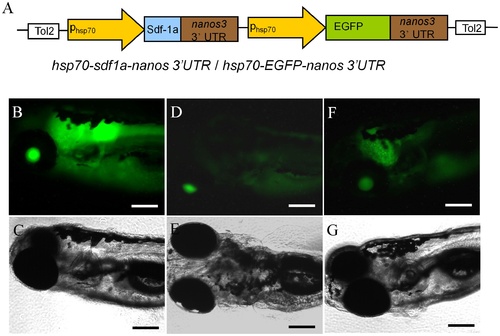- Title
-
Inducible Sterilization of Zebrafish by Disruption of Primordial Germ Cell Migration
- Authors
- Wong, T.T., and Collodi, P.
- Source
- Full text @ PLoS One
|
Generation of Tg(hsp70:sdf1a-nanos3, EGFP) zebrafish. (A) Diagram of the plasmid construct used to generate the transgenic line. A 1.5-kb fragment of the hsp70 promoter controls expression of zebrafish sdf1a and EGFP. Three different EGFP expression patterns were observed in F1 offspring obtained from different founder fish. (B,C) strong ubiquitous expression, (D,E) weak expression throughout the body, (F,G) strong expression in the brain and weak in the body. The strongly expressing larvae were raised to sexual maturity and used to establish the homozygous line. Scale bar = 200 μm. |
|
Heat induced expression of EGFP and sdf1a in Tg(hsp70:sdf1a-nanos3, EGFP) embryos. (A,B) Expression of EGFP was first observed at 30% epiboly in the embryos treated at 35.5°C, (C, D) 50% epiboly in the embryos treated at 34.5°C and (E, F) 2–5 somite in the embryos treated at 32.5°C. (G–N) EGFP expression was not detected by the 2 to 5 somite-stage in the embryos treated at 30.5 or 28.5°C. (O) The ubiquitous expression of sdf1a (dark blue) was quickly (less than 2 hours of staining) detected in heat-treated transgenic embryos started from late blastula stage. No obvious signal was seen in (P) non-heat-treated transgenic embryos, (Q) heat-treated wild-type embryos or (R) non-heat-treated wild-type embryos using the same staining condition. (S) No signal was detected when sdf1a sense riboprobe was used in heat-treated transgenic embryos as controls. Scale bar = 200 μm. EXPRESSION / LABELING:
|
|
Disruption of PGC migration in heat-treated Tg(hsp70:sdf1a-nanos3, EGFP)/Tg(kop:DsRed-nanos3) embryos. (A) Diagram of the plasmid construct used to generate the Tg(kop:DsRed-nanos3) zebrafish. A 3.8 kb fragment of the zebrafish kop promoter and nanos3 3?UTR control PGC-specific DsRed expression. (B–E) Photomicrographs showing PGC migration in heat-treated Tg(hsp70:sdf1a-nanos3, EGFP)/Tg(kop:DsRed-nanos3) embryos. In embryos treated at 34.5°C at 2dpf the majority of ectopically located PGCs were observed in (B) the tail, (C) the head and (D) along the outer surface of the yolk sac. (E) Fewer ectopic PGCs were observed in the embryos treated at 32.5°C and (F, G) at 30.5 and 28.5°C the majority of PGCs migrated to the gonadal region. (H, I) Mis-migrated PGCs (red) also express EGFP. (J–M) No significant disruption of PGC migration was found when embryos of Tg(kop:DsRed-nanos3) were heat-treated at temperatures ranging from 28.5 to 34.5°C for 18 hours. White arrows: DsRed-expressing PGCs; yellow arrows: gonadal region. Scale bar = 200 μm. |
|
Heat-treated transgenic embryos developed into infertile male adults. (A) No difference in appearance or overall size was observed between adult transgenic fish that developed from heat treated embryos and wild-type male. (B) No significant difference in body-weight of 3.5-month-old fish (n = 16 by random sampling) among heat-treat transgenic males, untreated transgenic males and wild-type males, and between the transgenic females and wild-type females. Data shared the same letter (A or B) are not significantly different from each other. Examination of gonadal tissue revealed that (C) A well-developed testis, C1, of untreated male transgenic fish. (D) A well-developed ovary, D1, of untreated female transgenic fish. (E) The gonads of heat-treated transgenic fish developed into a thin filament-like tissue, E1, surrounded by adipocytes. Photomicrograph showing (F) active spermatogenesis of the testis of untreated male transgenic fish, (G) a well-developed ovary with oocytes at different developmental stages of untreated female transgenic fish. (H) The gonad of heat-treated transgenic fish appears to be under-developed and surrounded with large amount of adipocytes without advanced gonadal structure or germ cells. WT: wild type; TG: transgenic; HT: heat treated. Scale bar: 1 cm for A, C–E and 50 μm for F–H. S: spermatozoa. |
|
Results from heat-treatment experiments on 1 hpf embryos of Tg(hsp70:sdf1a-nanos3, EGFP) at 34.5°C (H1-3), wild-type fish at 34.5°C (C1) or wild-type fish at 35.5°C (C2) for 18 hours. PHENOTYPE:
|





